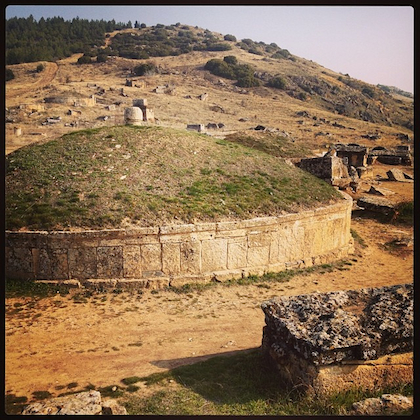Post #27 – where longevity and legacy are considered
During this #blogjune series of daily posts, I’ve found it very useful to peruse the photos I’ve posted to Instagram. I use an IFTTT recipe to copy all my instagrams to a folder in dropbox so I can have easy access to them. If I have some writer’s block and struggling for something to say, I find the photos a great way to prompt me as all sorts of things pop into my head.
When looking at the photo I’ve included below, I thought about the longevity of things. The picture is of the necropolis in the ancient city of Hierapolis in Turkey that was believed to have been founded over two thousand years ago. The hillside above the city was where they buried their dead and it’s covered with carved stone coffins. These Sarcophagi are dotted all over the hillside and some have even been either buried or exposed and tipped over as a result from past earthquake activity. They usually include some carved epitaph and inscription about the person inside and they range in size and ornateness. Many of them have been vandalised by grave robbers with holes punched through the lids or sides. What struck me though, was the durability of the stone, they obviously last much longer than a wooden coffin. There were also much larger tombs/temples and even burial mounds with space for a room inside them. These seem to be in better condition but also compromised by treasure seekers.
Anyway, this got me thinking about our learning resource and teaching materials. When I first studied at university we had access to wonderful printed study guides and readers (which are still in a bookcase at home), but now we generally only provide a digital version of learning resources. We put these online and update them as necessary, which I guess is a benefit as it’s easier to do it electronically, than go through and re-edit a document for re-printing… So, these resources as digital artefacts have a type of longevity, but they might lose their relevance over time. Many of our documents need updating for each teaching period, audio and video recordings can also date quickly and we have a process to regularly review and update lectures. Our multi-media resources are more difficult to edit as technologies and formats change and improve. I wonder what our legacy will be like for those who care to look at them in two thousand years time…
How do you mark or flag the relevance and/or longevity of your digital learning resources? Do you have processes for making the editing of multi-media resources easy and efficient?
The ancient cemetery (necropolis) at Hierapolis (Pamukkale), Turkey
Our Word of the Day (courtesy the Dictionary app) is: ‘environs’ – what surrounds you…
Tags: blogjune

I run some of my course sites on WordPress and I keep the materials on those sites intact for a couple of years. I started doing this because students asked if they could keep using the materials. In one unit, there is a learning activity each week and students have to complete half of them, but wanted to come back later and work through the others. When I update resources for future offerings of the course, I keep the original intact too so I don’t have broken links or embeds anywhere. I can do this because my content lives outside university systems. It would be harder to do within the corporate virtual learning environment.
As for updating things quickly: one trick I used this year was paying a transcriber to transcribe all of my mini lecture videos. This means I had a basic script for the majority of the videos I needed to make this year, and I could just update and re-record. Scripting takes time but I think is worth the effort because it helps me to create shorter, tighter videos. The $600 or so it cost to transcribe my existing videos was worth every cent, and more.
Resources have a longer life if they aren’t time specific. Most of my video content is reusable because it focuses on core concepts and theory. This works for me because I use classes to contextualise and explore the conceptual stuff in my videos, so there isn’t a need to have the time specific content in them. Most of the time I can reuse videos in full or part for later offerings, and transcribing them makes them super easy to update so it’s no big deal if I can’t reuse them anyway.